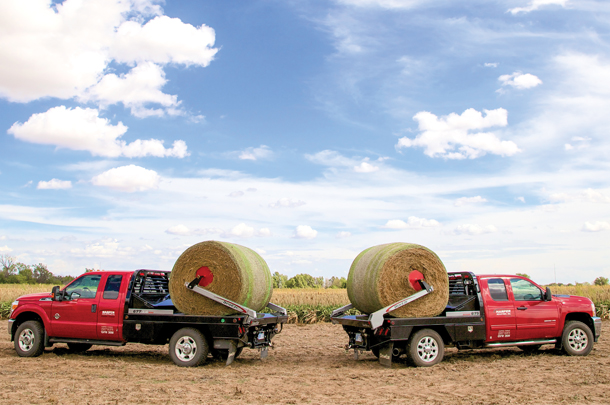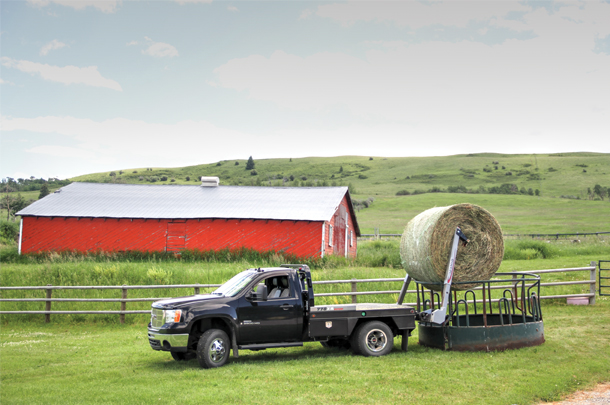One thing may have worked for them before, so why do it any differently the next time? Bale beds are certainly no exception to this thinking.
For instance, people in the southern U.S. tend to prefer parallel-squeeze bale bed models, while pivot-squeeze bale beds seem to be more popular farther north simply because those particular products have been used in those regions for a longer period of time.

Even though parallel-squeeze and pivot-squeeze bale beds have very similar capabilities and costs, the purchase decision should rely on more than personal preference. That’s because there are some small but often overlooked differences that can impact how the bale bed will perform.
Let’s start with pivot-squeeze models. For those unfamiliar with these bale beds, pivot-squeeze models have arms that pivot at the base, allowing the arms to open up to about 110 inches wide and close down to a narrow 34 inches for grabbing a variety of bale sizes.

Some users greatly prefer these types of bale beds because of this wide range of motion, and others feel it’s easier to line up with bales when using a pivot-squeeze bale bed.
On the other hand, parallel-squeeze models have arms that remain parallel at all times when they open and close to grab and release bales. It’s a reliable concept that’s been used on bale beds for many years. Some people prefer this simpler, more straightforward design (DewEze’s exclusive design since 1984).
Parallel-squeeze bale beds aren’t able to open as wide as pivot-squeeze models, which can limit the ability of loading large square bales. However, this really isn’t much of a drawback for parallel-squeeze bale beds since most people don’t use their bale beds for large square bales.
The biggest advantage of parallel-squeeze bale beds is the job they do unrolling bales. The parallel positioning of the arms and bale spinners tends to hold bales better, resulting in gentler handling and unmatched unrolling performance.
Although some pivot-squeeze bale beds have swivel spinners to keep the spinners at a parallel position to the bales, other pivot-squeeze spinners are not as forgiving.
Of course, there’s more to buying a bale bed than selecting between parallel-squeeze and pivot-squeeze. There are other important features that should be considered in the mix, such as wireless controls, enclosed adjustable gooseneck hitches and LED lighting.
Many of these have become standard across all makes and models of bale beds, but there are other useful features that are not as common.
For instance, not every product on the market has a corrosion-resistant surface coating. Some bale beds may only have painted steel decks, which are susceptible to rust, especially given some of the harsh weather many bale beds endure.
On the other hand, units with superior corrosion resistance are more likely to have a longer service life. In fact, it’s fairly common for these bale beds to outlast the truck.
Selecting the appropriate optional equipment is also key to a successful bale bed purchase. For example, swing lighting options help the operator see better on dark winter days. Lift bars allow the bale bed to perform lifting tasks beyond just bales.

Further, extendable arm beds include hydraulically telescoping arms for 20 inches of extra reach, which is helpful for placing hay in round bale feeders.
In addition to the bale beds themselves, the systems that power them play an equal role in performance. There are two ways to power a bale bed: an electric-over-hydraulic system or an under-hood hydraulic kit.
Although it’s the more expensive route, under-hood hydraulics are generally quicker and more durable with fewer maintenance worries. They have belt-driven pumps, which are independent of the transmission so the truck has complete freedom of movement.
Additionally, the under-hood hydraulics can be hooked up to power other implements besides the bale bed, if desired.
Because of the cost differences of the two hydraulic systems, it’s important for people to be cognizant when pricing a new bale bed. One dealer may provide a quote for a bale bed with an electric-over-hydraulic system, while another dealer gives a quote for a bale bed with under-hood hydraulics.
In these cases, some people automatically choose the cheaper bale bed when they probably would have preferred the higher-quality under-hood system had they been more informed on the situation.
Finally, one should always consider the warranty – not only on the bed itself but also on the hydraulic system to help ensure a long-lasting product. And if the truck may be traded off in the next several years, also consider the resale value of the bale bed since some may hold their value better than others.
All of this information goes without saying that having a good dealer is paramount to the success of any bale bed purchase, whether it’s a pivot-squeeze or parallel-squeeze unit with an electric-over-hydraulic system or under-hood hydraulics.
But with the help of a trusted dealer and a little knowledge on the different types of bale beds, it’s a lot easier to get the best bale bed for your buck … and your business. ![]()
PHOTO 1: Corrosion-resistant coatings, like those on the pictured pivot squeeze bale bed, promote long service life.
PHOTO 2: Pivot Squeeze Beds.JPG: A parallel squeeze bale bed (L) next to a pivot squeeze bale bed (R).
PHOTO 3: Pivot squeeze bale beds (pictured) can open up to about 110 inches wide and close down to 34 inches.
PHOTO 4: Extendable arm beds help operators place hay in round bale feeders. Photos courtesy of DewEze.

-
Tim Penner
- President
- Harper Industries












